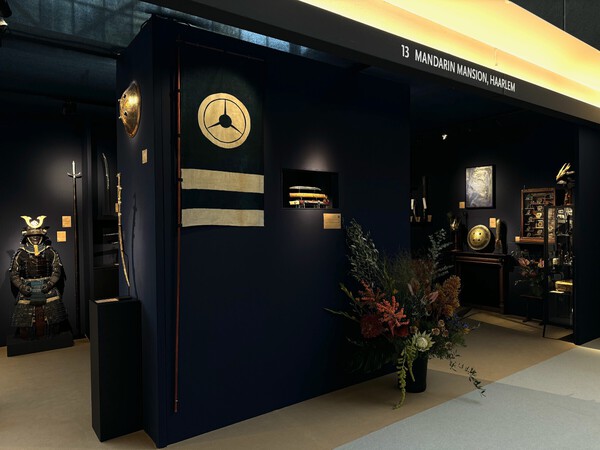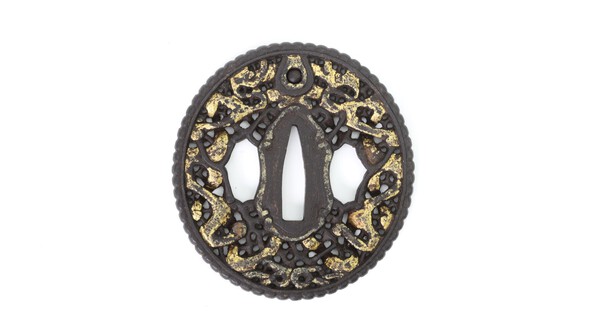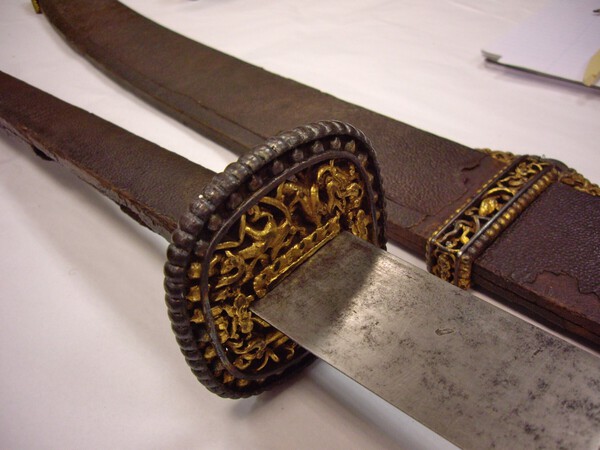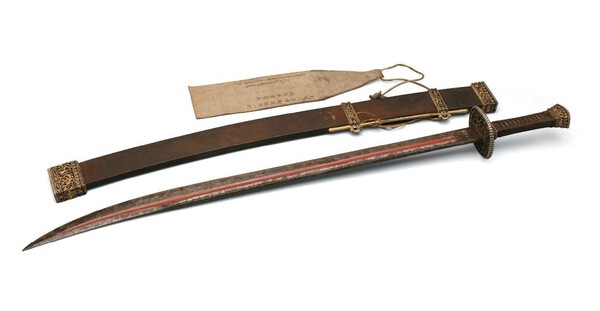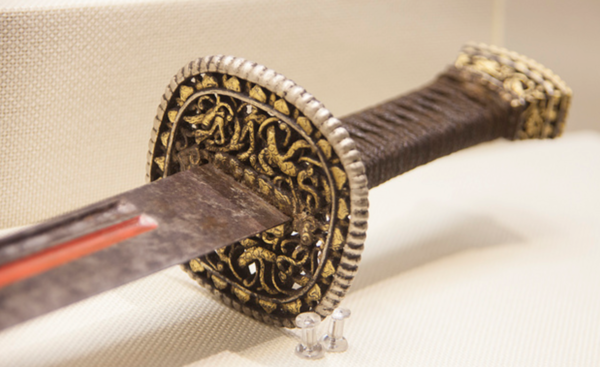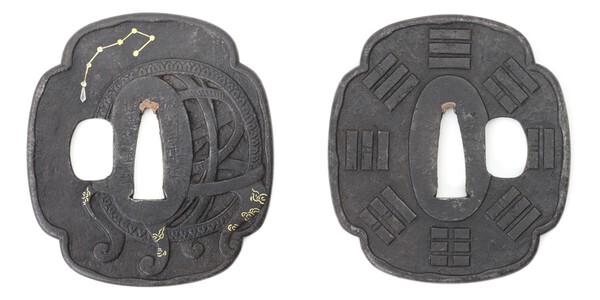-
Posts
33 -
Joined
-
Last visited
-
Days Won
3
Content Type
Profiles
Forums
Events
Store
Downloads
Gallery
Everything posted by Peter D
-
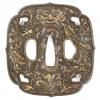
Hwando real korean or fake katana?
Peter D replied to vajo's topic in General Nihonto Related Discussion
Some Korean guards. Often with hitsu-ana that are more round on the inside. Sometimes larger, sometimes smaller than those found on Japanese examples. Nakago-ana often miss that narrowing towards the edge that you tend to see on Japanese work. -

Hwando real korean or fake katana?
Peter D replied to vajo's topic in General Nihonto Related Discussion
Korea is right in between the major powers Japan and China and it shows on their weapons and other regalia. They have a number of swords, some are much easier to differentiate from Japanese swords than others. Their straightswords generally follow the tradition of the Ming period in China, so they are easy to set apart from ken. Hwando Then there are the hwando, military sabers that are much more like Chinese yaodao (waist-worn sabers) than anything else. Korean swords are rare on the market, but this type turns up the most. The French army took a large number of them during a punitive expedition to Ganghwa Island in 1866, and they have been dispersed into collections worldwide since. Some have red writing on their sheats, dating to the late 18th century. All have iron mounts with silver overlay and octagonal guards. Occasionally, one sees guards separately sold as "nanban tsuba." The typical hwando, this one recently sold at Olympia Auction, lot 84. Wide blade more in the Chinese style. Typical Korean suspension system on scabbard, throatpiece missing. Grip wrap in the Japanese style but with hilt mounts following the late 18th-century Chinese transitional style between fangshi and yuanshi. (More about that here.) Joseon byeolun-geom Sabers worn by Joseon period military officials. This is the style most easily mistaken for Japanese swords. It is basically like a short tachi. Some of the best of them actually have Japanese-imported blades, so don't get distracted by the blade itself. Here is one I had, with a Japanese blade: The most obvious departures from Japanese design is the textile, if still present: a suspension system that more resembles the Chinese one, and a long tassel. Other tell-tale signs are the proportion of the hilt, and the fact it is often lacquered in the same style as the scabbard on this type of sword. Guards are modeled after Japanese guards but with odd placement and shape of the hitsu-ana. Often made of patinated silver, a Korean variety of shakudō but jade is also sometimes seen. The habaki also often look odd. Another aspect is that most of these were not made so they can be easily taken apart like the Japanese sword, so its often impossible to see the tang. Another one I had, again with a Japanese blade: Other types There is a whole range of other ceremonial Korean swords, but they are more easily discernible from Japanese swords because their blades are often roughly made and toy-like. They were more like a metal tsunagi sometimes. Here are two. -
Thanks, yes, if you can! The second character does look like 廣 "Hiro" from Mitsuhiro (光廣, the name ofed by the three Yagami mainline makers. However, the first character is certainly not Mitsu. Could you make a picture perhaps in broad daylight? Perhaps we can figure it out. @Spartancrest I looked into Haynes and there are a few 盛直 (Morinao) listed: One is published in Joly; Shōshankenshū. Section M, 489. Three more tsuba signed with that name are in Wakayama Toso Kinko Jiten, page 403, left, 5, 6, & 7. Does anyone have these publications handy? I don't have either! (I am looking for copies for my own library.) -Peter
-
That's a good point you're raising. Worthy of further research. Our handicap is how rare these are so its hard to gather enough data. But would it be possible to make a survey of signed ones and see if we can compare them with: 1. Known signatures of these makers 2. The work they normally did And see how much it differs. Makers could adopt various styles, but I noticed they rarely changed the fundamental ways in which they were trained and used to work.
-
Part of my work for the site involves making the field of arms collecting more approachable and less arcane. This is how I attempt to create interest among younger people who are less inclined to buy and read books. Many of the articles are also personal notes that I update as I learn more, and circle back to when I need to refresh my memory. Here is one I wrote about the construction methods of Japanese swords. A general introduction that introduces the methods most commonly encountered on swords or in the literature, and some more obscure ones. https://www.mandarin...hods-Japanese-swords
-
- 4
-

-

-

-
Thanks Ken! I'm glad we worked out something that we were both happy with. -Peter
-
Hi Colin! It's a very good and very legitimate question. Glad you asked so I can attempt to explain. Personally, I don't like price on request either, and I use it sparingly. I've just done an art show where I introduced some of this year's best items, and so you see more p.o.r. on my site now than normally is the case. My main reason for doing so: Suppliers and competitors also follow my site, and if they see a high-value item sell fast, they will adjust their prices for the next item accordingly. This drives prices up faster across the board than when they wouldn't have known. Also, on some very high-end pieces, buyers can be uncomfortable with the piece having been listed with the price exposed. But what you say is interesting. Maybe I should have more of an open mind and publish more prices and just see what happens.
-
I've always been puzzled about these, and since our initial research, a few signed ones have turned up that show these designs were, at the very least, also done in Japan by Japanese makers. Who knows, it is Japanese, after all, just taking strong inspiration from elsewhere. Or, like some chrysanthemum guards, perhaps production took place on both sides. Nagasaki and Tonkin (Hanoi) remained in contact in the 17th century through a trade ship going back and forth under a Chinese flag, which was owned by a Japanese Christian convert who had changed his name to Paolo Rodriguez. He was briefly heading the Dutch VOC operation there. Sword guards appear to have been part of underhand trade done by crews on such ships. What brought us to Vietnam was the lobed outline, which was very popular there, but then again, they probably got the idea from the Japanese. Another Vietnamese / Southern Chinese trait is the circular dot punch background that is common in China and Vietnam but not at all common in Japan. It is somewhat of a very lazy nanako. And lastly the "leafy" shapes of the star appear rather SE Asian. The preliminary conclusion is that they are probably part of cultural exchange, but I'm not sure where exactly they fit in. Does anyone know whether Hachiro Yamagami wrote about his? I wonder whether he related it to armor. -Peter
-
I think we need to step off this idea of the NBTHK as some sacred, all-knowing organization whose ways are set in stone. Their opinion is probably one of the best opinions we can get on swords, but it's still an opinion based on their current knowledge. And opinions can be subject to change when more facts present themselves. Have you read Darcy's article that was linked to above? From your posts, it seems you haven't taken the time to absorb that. Its a good example of only one of many instances where mei can differ but still be "correct". Another good example is the gimei Kotetsu blade worn by the Shinsengumi chief. He wore it as such historically. Why should we alter it now? Research is ongoing and may reveal important information later. It is important not to get stuck in dogma, especially when you're about to alter something on a sword that may have been there for centuries. If one buys an unpapered blade with a big name, its a very big risk unless one really knows what they are doing, and very few people do. We shouldn't destroy potentially important information on sword tangs just to protect this group of people.
-
You're going around in circles and fail to see the other side. We have already acknowledged that these exist, and are a problem, and such modern mei meant to deceive are best removed. However, as Darcy has pointed out, and I, and others, there are those mei that are old, not by the smith, but not meant to deceive. In some cases, we don't know too much about them other than that the style differs from the smith's own hand. If we remove them, we will never learn more. So the preservationists call for not indiscriminately remove all mei that differ slightly from the known mei in the books. That's all.
-
Interesting piece. The worn Fudo horimono and mitsu-mune are certainly hinting towards the Masamune. Nakago jiri is off, though, and it would be the only long mei in existence as well as the only tantō with this sugata. The inscription on the blade itself makes me think of the Kaifu smiths, some of whom had this habit of signing things on the blade. Markus Sesko lists a later Eishō period (1504-152) Masamune who signed “Sōshū-jū Gorō Nyūdō Masamune” (相州住五郎入道正宗), he was nicknamed Yamanouchi- Masamune (山内正宗). From the signature, it seems he was quite clearly a wannabe, so perhaps he modeled the details on his blade to known actual examples. -Markus Sesko; Swordsmiths of Japan, 2014. Page 546 Here is the (also somewhat worn) Fudo on an actual Masamune with Juyō papers.
-
@Matsunoki exactly! The loathing of gimei rests solely on the assumption that all are (recent) attempts at fraud. While this may often be the case, let's not carry away the wounded with the dead. There have for example been several cases of gimei blades where signatures were removed, after which the NBTHK attributed the blade to the very maker whose name was just removed. Certainly these mei weren't fraudulent in the sense that they were trying to attribute the blade to a better maker, they were honest attributions made by someone else, accurate enough for the NBTHK to come to the same conclusion. Who made the attribution we don't know. But if we remove them we are certain to never find out.
-
Historical objects have no obligation to us to look pretty. You can ignore those you don't like and the world won't be worse off. Altering them to one's own taste is permanent and to some extent, quite selfish. Removing an old gimei may one day be perceived the same as home polishing a Japanese sword. It's not about being PC. Its about preserving whatever historical information is there. False signatures are common throughout the sword world, from Europe to Persia. Only in Japan is it common practice to remove them, even if they are old. It is removing information that we one day may value more than we do now. Gimei might preserve provenance information we are currently not aware of. It is for example conceivable that certain Japanese sword collectors or their craftsmen inscribed their mumei blades in their own hand in the 17th or 18th century. We might only later find out what deliberate idiosyncracies in signatures to look for to attribute it to them. But with this current trend, by then, none may have survived. We also know that very notable smiths made gimei swords, in that case the whole sword plus the signature are their artwork. Isn't it more fair to keep the signature and just paper accordingly, noting that it's not by who the mei says it is? That's a far more honest type of connoisseurship to me. In essence, if we are to be influenced by modern trends in collecting, we are contributing to the loss of information that may later become more important than we realize now.
-
Hi! Welcome on my page. I'm Peter Dekker, researcher at heart, dealer by trade. I run www.mandarinmansion.com, focused on the research and trade of antique arms of Asia. Founded in 2005, I initially solely focused on Chinese arms, hence the name, as mandarins were the military and civilian officials of China. Interest eventually spread to neighboring cultures; Vietnam, Korea, India and also Japan. I mainly deal online but do art shows every now and then. My setup at PAN Amsterdam, 2023 Since 2016, Mandarin Mansion has been my full-time profession. Apart from trade, I help museums, scholars, and private collectors in research on subjects ranging from antique arms to Manchu archery, of which I am a practitioner. What I like about a multi-disciplinary approach is that it makes it easier for me to make comparative analyses between cultures. One of my personal interests, for example, is how cultures interact and influence each other. Apart from writing item descriptions, I am building an ever-expanding Glossary of arms-related terminology. I am pleased to meet you!
-
Time and time you fail to get into the nitty-gritty details you state are so important. I do, but you ignore those arguments. You're asking for tons of signed examples that you very well know do not exist. You must be referring to this piece: https://www.mandarin...-loukong-saber-guard I 100% stand by this assessment. Look at the center, a recess on one side for the angular ferrule of such sabers of which I posted a number previously. The other side has the typical ribbed design that shows on the blade side of these, always. The tang opening was cut open to accommodate a Japanese Nakano, now upside down because the Japanese would wear them edge-up. Style, workmanship, everything here is Chinese, 17th century. The swirling tendrils got more formalized in the later period, and were already more stiff during the Kangxi period. As exemplified by Kangxi to Qianlong period sabers of the style in Chinese government collections. Japanese copies skipped the recess for the square ferrule because it just wasn't practical, and also made the orientation of the nakago ana right from the get-go. It takes a lot of stubbornness to keep looking at this as "definitely Japanese." when everything about it points away from that. With other pieces, where an attribution is less straightforward, I express my uncertainties: https://www.mandarin...unusual-nanban-tsuba "The fineness of carving and the fact that much of the overlay is done over a cross-hatched background that is cut in three directions suggests the work is most likely done in Japan. If I had to guess, my mind goes towards the Nanban-style carvers in Yamashiro." https://www.mandarin...pierced-nanban-tsuba "This is a tough one to pinpoint but when looking solely at the fine carving in iron, the Yagami carvers of the 18th century come to mind, headed by Mitsuhiro, inventor of the "thousand monkeys" designs. However, they tended to finish the seppa-dai in a smooth manner while this one was carved with dragons." https://www.mandarin...-school-nanban-tsuba "In this case the finishing of the seppa-dai (washer plate) and both hitsu-ana (openings left and right) which are lined with a thin metal strip, plus the style and manner of carving, all point to Yagami school. Possibly the 2nd generation Mitsuhiro, the best of the three generations. One of his hallmarks was a complex rim where designs did not repeat itself, as seen here."
-
I've also found the "tradition" of removing signatures a strange one. If the signature is a recent addition, done with bad intent, sure. Remove and try to make the nakago look as it was best as we can. But I think it's never good to remove any kind of old information from an antique. Many of these gimei signatures were done a long time ago and may be part of the bonafide history of the sword. We may not know the exact reason now, but removing them will prevent us from ever finding out. One recognized instance where gimei is forgiven by the NBTHK is on blades by Muramasa whose signatures were known to be altered due to a Tokugawa dislike of the maker, especially in the hands of others but themselves. (Ieyasu kept his own!) Who knows what other legitimate reasons there may have been.
-
I just did! I have identified those features in all genres I have written about. But there are... We have provenanced 17th century material from Vietnam, well provenanced Chinese sabers and signed tsuba by Chinese makers working in Nagasaki Chinatown. Again you are making very broad statements because something annoys you, but you seem to willingly ignore all the work that has been done on the subject. ...but there is. Changes in the execution of dragons and clouds, in particular, have been very well documented through many mediums, from ironwork to silk robes and porcelain. One can certainly put a tentative and fair date range on a certain execution of such elements. Once one has a good grasp on all forms of Ming art, Ming stylistic metalwork starts to stand out. There is quite a consensus in the international scholar community on these stylistic changes. Earlier, you mentioned 100 as the price, so do you believe these were bought for $25? Anyway. Let's treat a specific one. give me a link and let's dissect a particular argument. And yes the Japanese did have VERY specific ways of working. That is exactly why unsigned swords and fittings can still often be attributed to specific schools, sometimes even individual makers. And interestingly, many nanban tsuba fall completely outside of any of these known schools. And, lo and behold, are identical to the ones I've seen on Chinese swords in which I have traded for over 20 years now. Moreover, didn't the Japanese need Chinese prototypes to copy to begin with? Would the Chinese have stopped their export of guards the moment Japanese makers also started to do them? Finding Chinese sword guards among tsuba on the Japanese market today is really not as big of a stretch as you so tenaciously try to make it seem. I think it's you who comes with very few definitive facts so far for your hypothesis that all are Japanese. -Peter
-
If the Japanese were so involved in copying these Chinese designs, and little to no actual Chinese designs made it to Japan, what did they base all these designs on? And with such a market for Chinese-inspired copies, is it logical that Chinese traders just stopped supplying their popular goods because now the Japanese just copied them? It makes no sense, really. Ok. Let's treat just one Chinese-made group I think I have identified: "...there was a third type derived from, or mixed with, Chinese influences. During the whole period of Portuguese and Dutch intercourse with Japan, the Chinese carried on a more or less uninterrupted trade with Kiushu ports, and, side by side with the purely Chinese· influence thus exerted, mixtures of European and Chinese styles, probably originating in Canton, are commonly found. Sword-guards of this class are generally termed Canton tsuba or Kagonami tsuba, presumably because this style originated in the city of Hanis, or was imported thence by the Celestial traders." -C.R. Boxer; European influence on Japanese fittings Canton was one of the main Asian cities of both production and trade. Anything could be made there if there was a market for it, and in Japan, a market for foreign-inspired tsuba existed. There is a group of such tsuba that combine a number of features that bring it home to Canton, from where most Chinese trade ships headed to Japan left. Undercutting: Undercut ironwork was produced in Beijing, Derge, and probably some other production centers. Canton was probably the most famous for its work in undercutting in various materials. The pinnacle of this art were the devil's work balls made of ivory. Many of the Canton tsuba feature balls or other elements that are completely cut loose from their surroundings. "Lazy" openwork through a multitude of drilled holes. Tsuba from the Canton group often are perforated with a large number of round holes. On the better work, each hole is filed out so that it is not obviously drilled anymore, but when mass production caught on in probably the 18th century, workers started to cut corners. This "lazy openwork" is very non-Japanese and is seen in all mediums in Southern China, including ivory, wood, and brass sword mounts for the local market. Lastly, surrounding the tang opening are often cloud or lingzhi forms that you also see on Cantonese sword mounts for the local market. Among Chinese swords, its a feature only seen among a group of them that often have Cantonese provenance so it really was a staple of that area. Here is an example of such work, combining these features. Even the application of the gold, over a two-directional crosshatched background, is typically Chinese. On Japanese work, generally three directions were used. The attribution of this tsuba from Japanese mass-produced item to Chinese mass-produced item for the Japanese market has no notable impact on the perceived value. Chinese collectors are not interested in goods made for export to Japan.
-
You're moving the goalposts. First, you state there are no Chinese swords with such guards, and when I show them, you say just because they look similar, they don't need to be. The Japanese copies can, in many cases, be clearly distinguished from the originals by the manner of carving, application of the gold, etc. There is also a group that defies classification, which is exactly what makes this a fun and interesting field of research. The devil is indeed in the details, but you don't seem interested in a constructive discussion on those specifics. Instead, you're making broad statements as to why non-Japanese classification could be untrue. When you think these tsubas are sold for 100 times the purchase price, you have a crooked idea of the market. I wish! They really don't sell like hotcakes. A Vietnamese attribution raising the price? No way; almost nobody collects Vietnamese arms unless they are complete and really good. On top of that, there is hardly any market for separate parts, Chinese or Vietnamese, with the exception of really good imperial Qing guards. -Peter
-
Here is a large two-hander in the Metropolitan Museum. I made this photo in the depot, it's not in their online accessible database. Accession number 36.25.1628 A-B. From the Max Dreger collection, sold in 1925. Here is the saber of Hong Taiji (1592-1643) in the Shenyang Palace Museum: The Hermitage in St. Petersburg also has a number of these, probably the largest collection of them in the world. Most were obtained by tribute and trade with the Qing, and some were collected by Czar Peter. I have photos of the depot but, unfortunately, do not have permission to share them widely. Some of the pieces were published recently in a Russian language book on Czar Peter. The reason why so few survive in China are the very effective purge on metalwork during the cultural revolution. Another reason is that the Chinese switched to soft metals by the late 18th century, almost entirely replacing pierced iron. This was gilt brass or copper for high-end pieces and plain brass for mid ranking officers and lower. Pierced iron only seems to have survived in Southern China. I think this because of a small group of rather similar mounts, with simplistic pierced work, that appear to have been made in Canton but with export to Japan in mind where earlier Chinese openwork had caught on and was produced by makers such as the Yagami school of Hizen. These Chinese pieces probably made it to Nagasaki by trade and it seems this continued for the 18th and perhaps well into the 19th century. Typical Cantonese features of this group are cloud shapes around the tang opening, elements like pearls that were cut loose, and on the lower end of these "lazy" piercing that consists of a series of round, drilled holes that are seen in the same way on brass mounts for the local Chinese market. For more on this group, see: https://www.mandarin...n-tsuba-canton-group -Peter
-
Sorry guys, I'm late to the party! I only just recently found out about this thread. The Hermitage in St. Petersburg has a sizeable collection of Chinese sabers with iron openwork mounts, mostly dating from the 17th century. The Palace Museum of Shenyang has the saber that belonged to Hong Taiji (1592-1642), and another large two-hander is in the Metropolitan Museum. They all exhibit the exact style of guard that sometimes turns up in Japan. From the overall style, to workmanship, to the method of applying the gold (which slightly differed from Japanese overlay), they are identical. And yes, sometimes one gets lucky and finds one on Yahoo Japan. The Japanese obviously had quite a taste for them; why else produce so many local varieties inspired by them. Studying these is quite difficult because Japanese artists were very good copiers. The field still requires a lot of pioneering and I may well be wrong on many attributions. But I have a reasoning behind each and every attribution I have made on my site. I encourage you to pick one out and try my methods. I'll follow up with why I think it is so. I do agree with you that 99% of the ones on the market are Japanese-made. This is not reflected on my website for the simple reason that I am usually specifically looking for the Chinese ones. So yes you will find a disproportionate amount of Chinese attributed pieces on my site and in my writings, because that is where my interest is. And no, it is not, as you insinuate, just a ploy to make money. This is just a personal interest. Nothing I ever wrote or said about Nanban Tsuba will ever get close to paying my bills. Furthermore, I have no need whatsoever to taint my reputation by overselling relatively cheap sword guards. What I write about them is what I think, and what I think is based on lots of study, contemplation, and discussion. Still, they are preliminary conclusions.
-
Thanks! Sure, be my guest. I do update my articles when I find new info, so it could be the site will be more elaborate in a while. But I have nothing against you sharing it here in PDF. @Winchester very interesting! What do you think the signature says? From the carving, it could be one of the Yagami makers. It's interesting that they didn't see the signature on the Yakushi. I also have a papered Nanban tsuba with Western script all over it and no mention of it on the papers. I am like, guys, isn't this obviously a notable feature? -Peter
-
It wasn't as fine as the better traditional Japanese polishes indeed. But if the blade wasn't Japanese, as the tang suggested, then this polish is totally fine. @Ynot "cut-throat marketing" ... That's a very unkind judgment, based on very little information, since you didn't even care to read the article. The piece is sold now. But as stated, I had from its previous owner many letters in correspondence directly with Tanobe-san when he was still heading the NBTHK. They didn't paper it because it was outside their field of expertise, but he did classify it as a pre-Koto piece. Also, if it is Chinese, it would fall outside the NBTHK's official scope, as per their own regulations. -Peter
-
Hi, One of my fields of interest is Asian trade relations and their effect on material culture. So naturally I am drawn to "nanban tsuba". I'm working on an ongoing article on rare signed pieces that help draw a picture of who produced what, when. https://www.mandarin.../signed-nanban-tsuba If you have any interesting signed nanban tsuba that you would like incorporated, let me know. I want to make it as comprehensive as I can. One thing that caught my attention was the incredible similarity between Hirado Kunishige and some works of the Ichinomiya school in Kyoto. I currently maintain two hypotheses on this: 1. Works from Hirado Kunishige made it to Kyoto on diplomatic and trade missions, and local workers copied their unusual style faithfully. 2. Kunishige was trained in Kyoto and maintained ties with his former school. In the 18th century, Kunishige was Hirado's only known maker. Who taught him the craft? Hypothesis 1 is the most straightforward but leaves the question of his training background unanswered. Anyway, I hope you enjoy the article. -Peter
- 16 replies
-
- 12
-

-

-
Hi! I see some years have passed again, but here is mine. Another by Umetada Tachibana Shigeyoshi who seemed to have done the most of them. Signature: 城州西陣住 Joshu Nishijin-jū “Resident of Yamashiro Nishijin” (An area in Kyoto) 埋忠橘重義 Umetada Tachibana Shigeyoshi The 1608 dated example is a wonderful reference. It coincides with Markus Sesko's placing of Umetada Tachibana Shigeyoshi as the second generation after Umetada Myōju in "Genealogies of Tsuba Makers", which in turn was based on Fukushi Shigeo; "Tōsō-tōsōgu shogaku-kyōshitsu 179“, „Tōken-Bijutsu No. 634“, NBTHK.













